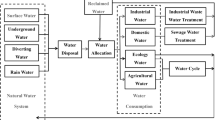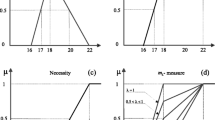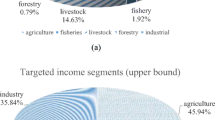Abstract
Environmental and ecological issues caused by water resources crisis have brought enormous challenges to the sustainable development of water-deficient area. Water resources allocation management balancing the relationship between the social-economic development and the ecological environment has become a hot topic in recent years. In this paper, an inexact fuzzy chance-constrained programming (IFCCP) approach is proposed for regional water resource allocation optimization with the aim of promoting the harmonious development of the social economic and the ecological environment, improving water utilization efficiency, and realizing water resources consumption control under uncertainties. The method is incorporated with interval parameter programming, fuzzy programming, and chance-constrained programming, for handling system uncertainties and balancing the optimal objectives with the risk of violating system constraints. Under this framework, an IFCCP model for water resources allocation management was successfully formulated and applied to a typical water-deficit area, Tianjin, China, for obtaining a better water resources plan among multiple users under resources and environmental limitation. Different total water consumption control policies are designed for assessing regional water allocation schemes. The results indicated that the gap of supply and demand will only be solved by foreign water, the transferred water from Luan River and Changjiang River would still be the main supplier in planning horizon. Moreover, the strict total water consumption control policy would guarantee the water requirement of ecological environment, lead to changes in the structure of water supply, actively guide on water conservation, and promote the large-scale utilization of desalted water and recycle water.






Similar content being viewed by others
References
Bai XM, Imura H (2001) Towards sustainable urban water resources management: a case study in Tianjin, China. Sustain Dev 9:24–35
Chen XY, Chau KW (2016) A hybrid double feed forward neural network for suspended sediment load estimation. Water Resour Manage 30:2179–2194
Chen CH, Huang Y, Li GF (2011) Study on integrated approaches of water resources allocation in Tianjin. Adv Mater Res 243–249:4516–4519
Dai C, Cai YP, Lu WT, Liu H, Guo HC (2016) Conjunctive water use optimization for watershed-lake water distribution system under uncertainty: a case study. Water Resour Manage 12(30):4429–4449
Davies EGR, Simonovic SP (2011) Global water resources modeling with an integrated model of the social–economic–environmental system. Adv Water Resour 34(6):684–700
Gu JJ, Guo P, Huang GH (2016) Achieving the objective of ecological planning for arid inland river basin under uncertainty based on ecological risk assessment. Stoch Environ Res Risk Assess 5(30):1485–1501
Huang GH (1998) A hybrid inexact-stochastic water management model. Eur J Oper Res 107:137–158
Huang GH, Loucks DP (2000) An inexact two-stage stochastic programming model for water resources management under uncertainty. Civil Eng Environ Syst 17:95–118
Ji Y, Huang GH, Guo H, Sun W (2015a) Risk assessment of hydropower stations through an integrated fuzzy entropy-weight multiple criteria decision making method: a case study of the Xiangxi River. Expert Syst Appl 12(42):5380–5389
Ji L, Niu DX, Xu M, Huang GH (2015b) An optimization model for regional micro-grid system management based on hybrid inexact stochastic-fuzzy chance-constrained. Int J Electr Power Energy Syst 64:1025–1039
Ji L, Sun P, Ma Q, Na J, Huang GH, Xie YL (2017) Inexact two-stage stochastic programming for water resources allocation under considering demand uncertainties and response—a case study of Tianjin, China. Water 9(6):414. https://doi.org/10.3390/w9060414
Li YP, Huang GH, Nie SL (2011) Optimization of regional economic and environmental systems under fuzzy and random uncertainties. J Environ Manage 92:2010–2020
Li XM, Lu HW, Li J, Du P, Xu M, He L (2015) A modified fuzzy credibility constrained programming approach for agricultural water resources management—a case study in Urumqi, China. Agric Water Manag 156:79–89
Liu J, Li YP, Huang GH, Zhuang XW, Fu HY (2017) A assessment of uncertainty effects on crop planning and irrigation water supply using a Monte Carlo simulation based dual-interval stochastic programming method. J Clean Prod 149:945–967
Lu H, Du P, Chen Y, He L (2016) A credibility-based chance-constrained optimization model for integrated agricultural and water resources management: a case study in South Central China. J Hydrol 537:408–418
Ma X, Ma C, Wan Z, Wang K (2016) A fuzzy chance-constrained programming model with type 1 and type 2 fuzzy sets for solid waste management under uncertainty. Eng Optim 6(49):1040–1056
Martínez G, Anderson L (2015) A risk-averse optimization model for unit commitment problems. In: 2015 48th Hawaii International Conference on System Sciences, pp 2577–2585
Nabavi-Pelesaraei A, Bayat R, Hosseinzadeh-Bandbafha H, Afrasyabi H, Chau K (2017) Modeling of energy consumption and environmental life cycle assessment for incineration and landfill systems of municipal solid waste management—a case study in Tehran Metropolis of Iran. J Clean Prod 148:427–440
Niu G, Li YP, Huang GH, Liu J, Chen M (2016) Interactive fuzzy-boundary interval programming for water resources management of the Hetao Basin, China. J Irrig Drain Eng 142(12):04016056
Olvaie E, Baneiad H, Chau K, Melesse AM (2015) A comparison of various artificial intelligence approaches performance for estimating suspended sediment load of river systems: a case study in United States. Environ Monit Assess 187:189
Roubens M, Teghem J (1991) Comparison of methodologies for fuzzy and stochastic multi-objective programming. Fuzzy Sets Syst 42:119–132
Sefeedpari P, Rafiee S, Akram A, Chau K, Pishgar-Komleh SH (2016) Prophesying egg production based on energy consumption using multi-layered adaptive neural fuzzy inference system approach. Comput Electron Agric 13:10–19
Suárez-Almiñana S, Pedro-Monzonís M, Paredes-Arquiola J, Andreu J, Solera A (2017) Linking Pan-European data to the local scale for global change and water scarcity within water resources planning and management. Sci Total Environ 603–604:126–139
Sun L, Li C, Cai Y, Wang X (2017) Interval optimization model considering terrestrial ecological impacts for water rights transfer from agriculture to industry in Ningxia, China. Sci Rep 7, Article number: 3465. https://doi.org/10.1038/s41598-017-02734-9
Taormina R, Chau K, Sivakumar B (2015) Neural network river forecasting through baseflow separation and binary-coded swarm optimization. J Hydrol 529:1788–1797
Tianjin Municipal Government (2016) Tianjin General Planning (2015–2030). Tianjin Municipal Government, Tianjin
Tianjin Municipality’s Water Conservancy Bureau (2016) Tianjin Water Resources Bulletin 2015. Tianjin Municipality’s Water Conservancy Bureau, Tianjin
Tianjin Statistic Bureau (2016) Tianjin statistical yearbook 2015. China Statistics Press, Beijing
Wang W, Xu D, Chau K, Lei G (2014) Assessment of river water quality based on theory of variable fuzzy sets and fuzzy binary comparison method. Water Resour Manage 28:4183–4200
Wang Y, Zhao S, Zhou Z, Botterud A, Xu Y, Chen R (2017) Risk adjustable day-ahead unit commitment with wind power based on chance constrained goal programming. IEEE Trans Sustain Energy 8(2):530–541
Xi RC, Gu YJ (2018) Analysis and research on the optimal allocation of regional water resources. In: E3S Web of Conferences, vol 38, pp 03055
Xie YL, Huang GH, Li W, Li JB, Li YF (2013) An inexact two-stage stochastic programming model for water resources management in Nansihu Lake Basin, China. J Environ Manage 127:188–205
Xie YL, Xia DH, Huang GH, Li W, Xu Y (2017) A multistage stochastic robust optimization model with fuzzy probability distribution for water supply management under uncertainty. Stoch Environ Res Risk Assess 1(31):125–143
Xu Y, Li W, Ding X (2017a) A stochastic multi-objective chance-constrained programming model for water supply management in Xiaoqing river watershed. Water 9(6):378. https://doi.org/10.3390/w9060378
Xu Y, Cabrerizo FJ, Herrera-Viedma E (2017b) A consensus model for hesitant fuzzy preference relations and its application in water allocation management. Appl Soft Comput 58:265–284
Xu J, Huang G, Li Z, Chen J (2017c) A two-stage fuzzy chance-constrained water management model. Environ Sci Pollut Res 24:12437–12454
Zadeh LA (1965) Fuzzy sets. Inf Control 8(3):338–353
Zhai YY, Huang GH, Zhou Y, Zhou X (2016) A factorial dual-interval programming approach for planning municipal waste management systems. J Environ Eng 142(8):04016033
Zhang YM, Huang GH, Lu HW, He L (2015) Planning of water resources management and pollution control for Heshui River Watershed, China: a full credibility- constrained programming approach. Sci Total Environ 524–525:280–289
Zhuang XW, Li YP, Huang GH, Zeng XT (2015) An inexact joint-probabilistic programming method for risk assessment in water resources allocation. Stoch Environ Res Risk Assess 5(29):1287–1301
Acknowledgements
The work is financial supported by Natural Science Foundation of Beijing Municipality (Grant No. 9174028) and National Natural Science Foundation of China (Grant Nos. 71603016 and U1765101). The authors are also grateful for the valuable comments of anonymous reviewers and editor, which help to improve the manuscript greatly.
Author information
Authors and Affiliations
Corresponding author
Rights and permissions
About this article
Cite this article
Ji, L., Huang, G. & Ma, Q. Total consumption controlled water allocation management for multiple sources and users with inexact fuzzy chance-constrained programming: a case study of Tianjin, China. Stoch Environ Res Risk Assess 32, 3299–3315 (2018). https://doi.org/10.1007/s00477-018-1627-9
Published:
Issue Date:
DOI: https://doi.org/10.1007/s00477-018-1627-9




